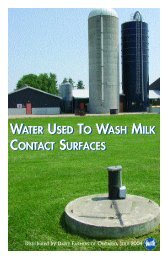Canadian Quality Milk On-Farm Food Safety Program - Centre ...
Canadian Quality Milk On-Farm Food Safety Program - Centre ...
Canadian Quality Milk On-Farm Food Safety Program - Centre ...
Create successful ePaper yourself
Turn your PDF publications into a flip-book with our unique Google optimized e-Paper software.
<strong>Canadian</strong> <strong>Quality</strong> <strong>Milk</strong><br />
HAZARD SOURCE BEST MANAGEMENT PRACTICES<br />
Contamination of milk<br />
with foreign material<br />
Broken needles in meat<br />
(CCP3)<br />
<strong>Milk</strong> house<br />
• Broken glass<br />
• Oil and dirt from<br />
compressors, vacuum<br />
pumps etc.<br />
• Intramuscular and<br />
subcutaneous injection<br />
of livestock medicines<br />
PHYSICAL<br />
Protect lights near the man-hole of the bulk tank or<br />
ensure bulbs have a protective coating<br />
Operate and maintain equipment to reduce oil and<br />
dirt build-ups, and if possible install in a separate<br />
utility room.<br />
See Chapter 7.<br />
Record the animal and site of the broken needle.<br />
Have a veterinarian remove the broken needle<br />
⎯ if this is not possible; inform packing plant or<br />
next buyer of broken needle.<br />
Have a written plan to deal with the situation<br />
where a treated animal or an animal with a<br />
broken needle has been sold and the next buyer<br />
was not informed?<br />
Use recommended tools and techniques when<br />
administering injections.<br />
Ensure animal to be injected is properly<br />
restrained.<br />
Use subcutaneous route to administer<br />
medications by injection if label permits.<br />
Buy animals from a reliable source that do not<br />
contain broken needles.<br />
See Chapters 3, 4 and 8.<br />
Appendix I - 8<br />
June 2010
















